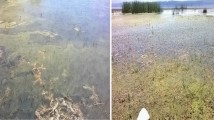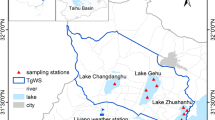Abstract
It remains unclear why the area of a cyanobacterial bloom increases in a shallow lake after a typhoon passes. In this study, the mechanisms of cyanobacterial bloom expansion were investigated by studying meteorological factors, water quality, algal biomass, and bloom area in Lake Taihu before and after typhoons (2007–2016). Our results showed that typhoon-induced sediment resuspension caused a short-term increase in nutrients, but nutrients returned to pre-typhoon levels after the typhoon passages. The short-term nutrient release during a typhoon did not result in an obvious increase in Microcystis cell density in two bays of Lake Taihu (Gonghu and Meiliang). Under strong winds, Microcystis aggregates were uniformly distributed in the water column downwind and then dispersed into different directions by wind-driven currents. In particular, Microcystis in the surface water were transported to the center of Lake Taihu. After a typhoon, dispersed Microcystis refloated and formed blooms. Thus, the bloom area was enlarged compared with before a typhoon. Several days after a typhoon, the bloom area gradually reduced as a result of a steady breeze on the horizontal accumulation of Microcystis.










Similar content being viewed by others
References
Aparicio Medrano E, Uittenbogaard RE, Dionisio Pires LM, van de Wiel BJH, Clercx HJH (2013) Coupling hydrodynamics and buoyancy regulation in Microcystis aeruginosa for its vertical distribution in lakes. Ecol Model 248:41–56. https://doi.org/10.1016/j.ecolmodel.2012.08.029
Barton AD, Ward BA, Williams RG, Follows MJ (2014) The impact of fine-scale turbulence on phytoplankton community structure. Limnol Oceanogr Fluids Environ 4:34–49
Cao H-S, Kong F-X, Luo L-C, Shi X-L, Yang Z, Zhang X-F, Tao Y (2006) Effects of wind and wind-induced waves on vertical phytoplankton distribution and surface blooms of Microcystis aeruginosa in Lake Taihu. J Freshw Ecol 21:231–238
Chacko N (2017) Chlorophyll bloom in response to tropical cyclone Hudhud in the bay of Bengal: Bio-Argo subsurface observations. Deep Sea Res Part I Oceanogr Res Pap 124:66–72. https://doi.org/10.1016/j.dsr.2017.04.010
Chacko N, Zimik L (2018) Effect of Cyclone Thane in the bay of Bengal explored using Moored Buoy Observations and Multi-platform Satellite Data. J Indian Soc Remote Sens 46:821–828. https://doi.org/10.1007/s12524-017-0748-9
Chen Y, Qin B, Teubner K, Dokulil MT (2003) Long-term dynamics of phytoplankton assemblages: Microcystis-domination in Lake Taihu, a large shallow lake in China. J Plankton Res 25:445–453
Deng J, Chen F, Liu X, Peng J, Hu W (2016) Horizontal migration of algal patches associated with cyanobacterial blooms in an eutrophic shallow lake. Ecol Eng 87:185–193. https://doi.org/10.1016/j.ecoleng.2015.12.017
Ding Y, Qin B, Zhu G, Wu T, Wang Y, Luo L (2012) Effects of typhoon Morakot on a large shallow lake ecosystem, Lake Taihu. China Ecohydrol 5:798–807
Ebina J, Tsutsui T, Shirai T (1983) Simultaneous determination of total nitrogen and total phosphorus in water using peroxodisulfate oxidation. Water Res 17:1721–1726
Emanuel K (2005) Increasing destructiveness of tropical cyclones over the past 30 years. Nature 436:686–688
Gao G, Zhu G, Qin B, Chen J, Wang K (2006) Alkaline phosphatase activity and the phosphorus mineralization rate of Lake Taihu Science In China. Series D Earth Sci 49:176–185. https://doi.org/10.1007/s11430-006-8117-5
George D, Edwards R (1976) The effect of wind on the distribution of chlorophyll a and crustacean plankton in a shallow eutrophic reservoir. J Appl Ecol:667–690. https://doi.org/10.2307/2402246
Hamilton D, Mitchell S (1997) Wave-induced shear stresses, plant nutrients and chlorophyll in seven shallow lakes. Freshw Biol 38:159–168. https://doi.org/10.1046/j.1365-2427.1997.00202.x
Hu C, Lee Z, Ma R, Yu K, Li D, Shang S (2010) Moderate resolution imaging spectroradiometer (MODIS) observations of cyanobacteria blooms in Taihu Lake. China J Geophys Res Oceans 115. https://doi.org/10.1029/2009JC005511
Huisman J, Sharples J, Stroom JM, Visser PM, Kardinaal WEA, Verspagen JM, Sommeijer B (2004) Changes in turbulent mixing shift competition for light between phytoplankton species. Ecology 85:2960–2970
Jeppesen E, Kronvang B, Meerhoff M, Søndergaard M, Hansen KM, Andersen HE, Lauridsen TL, Liboriussen L, Beklioglu M, Özen A, Olesen JE (2009) Climate change effects on runoff, catchment phosphorus loading and lake ecological state, and potential adaptations. J Environ Qual 38:1930–1941. https://doi.org/10.2134/jeq2008.0113
Joung S, Kim C, Ahn C, Jang K, Boo SM, Oh H (2006) Simple method for a cell count of the colonial cyanobacterium, Microcystis sp. J Microbiol Seoul 44:562
Li M, Xiao M (2014) In situ growth rate of Microcystis in a hypertrophic lake: RNA/DNA ratio as an indicator. Fresenius Environ Bull 23:1100–1106
Li M, Xiao M, Zhang P, Hamilton DP (2018) Morphospecies-dependent disaggregation of colonies of the cyanobacterium Microcystis under high turbulent mixing. Water Res 141:340–348. https://doi.org/10.1016/j.watres.2018.05.017
Lin I, Liu WT, Wu CC, Wong GTF, Hu C, Chen Z, Liang WD, Yang Y, Liu KK (2003) New evidence for enhanced ocean primary production triggered by tropical cyclone. Geophys Res Lett:30. https://doi.org/10.1029/2003gl017141
McGillicuddy DJ et al (2007) Eddy/wind interactions stimulate extraordinary mid-ocean plankton blooms. Science 316:1021–1026
Michalak AM et al (2013) Record-setting algal bloom in Lake Erie caused by agricultural and meteorological trends consistent with expected future conditions. Proc Natl Acad Sci U S A 110:6448–6452. https://doi.org/10.1073/pnas.1216006110
Moreno-Ostos E, Cruz-Pizarro L, Basanta A, George DG (2008) The influence of wind-induced mixing on the vertical distribution of buoyant and sinking phytoplankton species. Aquat Ecol 43:271–284. https://doi.org/10.1007/s10452-008-9167-x
Nakamura T (1993) Flotation and sedimentation of a single Microcystis floc collected from surface bloom. Wat Res 27:979–983
Otten TG, Paerl HW (2011) Phylogenetic inference of colony isolates comprising seasonal Microcystis blooms in Lake Taihu. China Microbial Ecol 62:907–918. https://doi.org/10.1007/s00248-011-9884-x
Paerl HW, Otten TG (2013) Harmful cyanobacterial blooms: causes, consequences, and controls. Microb Ecol 65:995–1010
Paerl HW, Bales JD, Ausley LW, Buzzelli CP, Crowder LB, Eby LA, Fear JM, Go M, Peierls BL, Richardson TL, Ramus JS (2001) Ecosystem impacts of three sequential hurricanes (Dennis, Floyd, and Irene) on the United States’ largest lagoonal estuary, Pamlico Sound. NC Proc Natl Acad Sci U S A 98:5655–5660. https://doi.org/10.1073/pnas.101097398
Paerl HW, Xu H, McCarthy MJ, Zhu G, Qin B, Li Y, Gardner WS (2011) Controlling harmful cyanobacterial blooms in a hyper-eutrophic lake (Lake Taihu, China): the need for a dual nutrient (N & P) management strategy. Water Res 45:1973–1983. https://doi.org/10.1016/j.watres.2010.09.018
Prairie JC, Sutherland KR, Nickols KJ, Kaltenberg AM (2012) Biophysical interactions in the plankton: a cross-scale review. Limnol Oceanogr Fluids Environ 2:121–145
Qin B et al (2000) Studies on the hydrodynamic processes and related factors in Meiliang Bay, northern Taihu Lake. China J Sci 12:327–334
Qin B, Yang G, Ma J, Wu T, Li W, Liu L, Deng J, Zhou J (2018) Spatiotemporal changes of Cyanobacterial bloom in large shallow eutrophic Lake Taihu. China Front Microbiol 9:451. https://doi.org/10.3389/fmicb.2018.00451
Reddy PRC, Salvekar PS, Nayak S (2008) Super cyclone induces a mesoscale phytoplankton bloom in the bay of Bengal. IEEE Geosci Remote Sens Lett 5:588–592. https://doi.org/10.1109/lgrs.2008.2000650
Reynolds CS, Walsby AE (1975) Water-blooms. Biol Rev 50:437–481
Schelske CL, Carrick HJ, Aldridge FJ (1995) Can wind-induced resuspension of meroplankton affect phytoplankton dynamics? J N Am Benthol Soc 14:616–630. https://doi.org/10.2307/1467545
Shi K et al (2015) Long-term satellite observations of microcystin concentrations in Lake Taihu during Cyanobacterial bloom periods. Environ Sci Technol 49:6448–6456. https://doi.org/10.1021/es505901a
Søndergaard M, Kristensen P, Jeppesen E (1992) Phosphorus release from resuspended sediment in the shallow and wind-exposed Lake Arresø. Denmark Hydrobiologia 228:91–99
Verhagen JH (1994) Modeling phytoplankton patchiness under the influence of wind-driven currents inlakes. Limnol Oceanogr 39:1551–1565
Wang YK, Chun YE, Zhang DL, Chun-Hua LI (2015) Effect of spatial distribution on inflow ability of non-point source pollutants into the lake. J Environ Eng Technol 5:478–484
Wang T, Liu GP, Gao L, Zhu LX, Li DJ (2017) Biological responses to nine powerful typhoons in the East China Sea. Reg Envir Chang 17:465–476. https://doi.org/10.1007/s10113-016-1025-0
Webster IT, Hutchinson PA (1994) Effect of wind on the distribution of phytoplankton cells in lakes revisited. Limnol Oceanogr 39:365–373
Webster PJ, Holland GJ, Curry JA, Chang HR (2005) Changes in tropical cyclone number, duration, and intensity in a warming environment. Science 309:1844–1846. https://doi.org/10.1126/science.1116448
Wu X, Kong F (2009) Effects of light and wind speed on the vertical distribution of Microcystis aeruginosa colonies of different sizes during a summer bloom. Int Rev Hydrobiol 94:258–266
Wu X et al (2010) Horizontal distribution and transport processes of bloom-forming Microcystis in a large shallow lake (Taihu, China). Limnol Ecol Manag Inland Waters 40:8–15. https://doi.org/10.1016/j.limno.2009.02.001
Wu T, Qin B, Zhu G, Luo L, Ding Y, Bian G (2013) Dynamics of cyanobacterial bloom formation during short-term hydrodynamic fluctuation in a large shallow, eutrophic, and wind-exposed Lake Taihu. China Environ Sci Pollut Res 20:8546–8556
Wu TF, Qin B, Ding W, Zhu G, Zhang Y, Gao G, Xu H, Li W, Dong B, Luo L (2018) Field observation of different wind-induced basin-scale current field dynamics in a large, Polymictic, Eutrophic Lake. J Geophys Res Oceans 123:6945–6961. https://doi.org/10.1029/2018jc014040
Xiao M, Li M, Reynolds CS (2018) Colony formation in the cyanobacterium Microcystis. Biol Rev Camb Philos Soc 93:1399–1420. https://doi.org/10.1111/brv.12401
Xu H, Paerl HW, Qin B, Zhu G, Gaoa G (2010) Nitrogen and phosphorus inputs control phytoplankton growth in eutrophic Lake Taihu. China Limnol Oceanogr 55:420–432
Yang Z, Zhang M, Shi X, Kong F, Ma R, Yu Y (2016) Nutrient reduction magnifies the impact of extreme weather on cyanobacterial bloom formation in large shallow Lake Taihu (China). Water Res 103:302–310. https://doi.org/10.1016/j.watres.2016.07.047
Zhang Q, Li L (2009) Development and application of an integrated surface runoff and groundwater flow model for a catchment of Lake Taihu watershed. China Quat Int 208:102–108. https://doi.org/10.1016/j.quaint.2008.10.015
Zhang YC, Ma RH, Duan HT, Loiselle SA, Xu JD, Ma MX (2014) A Novel algorithm to estimate algal bloom coverage to subpixel resolution in Lake Taihu. IEEE J Sel Top Appl Earth Observ Remote Sens 7:3060–3068. https://doi.org/10.1109/jstars.2014.2327076
Zhao H, Tang D, Wang D (2009) Phytoplankton blooms near the Pearl River estuary induced by Typhoon Nuri. J Geophys Res Oceans 114. https://doi.org/10.1029/2009jc005384
Zheng GM, Tang D (2007) Offshore and nearshore chlorophyll increases induced by typhoon winds and subsequent terrestrial rainwater runoff. Mar Ecol Prog Ser 333:61–74. https://doi.org/10.3354/meps333061
Zhou J et al (2015) Effects of wind wave turbulence on the phytoplankton community composition in large, shallow Lake Taihu. Environ Sci Pollut Res 22:12737–12746. https://doi.org/10.1007/s11356-015-4535-2
Zhu M, Paerl HW, Zhu G, Wu T, Li W, Shi K, Zhao L, Zhang Y, Qin B, Caruso AM (2014a) The role of tropical cyclones in stimulating cyanobacterial (Microcystis spp.) blooms in hypertrophic Lake Taihu. China Harmful Algae 39:310–321. https://doi.org/10.1016/j.hal.2014.09.003
Zhu W et al (2014b) Vertical distribution of Microcystis colony size in Lake Taihu: its role in algal blooms. J Great Lakes Res 40:949–955. https://doi.org/10.1016/j.jglr.2014.09.009
Zhu QD, Sun JH, Hua GF, Wang JH, Wang H (2015) Runoff characteristics and non-point source pollution analysis in the Taihu Lake Basin: a case study of the town of Xueyan. China Environ Sci Pollut Res 22:15029–15036. https://doi.org/10.1007/s11356-015-4709-y
Zhu W, Zhou X, Chen H, Gao L, Xiao M, Li M (2016) High nutrient concentration and temperature alleviated formation of large colonies of Microcystis: evidence from field investigations and laboratory experiments. Water Res 101:167–175. https://doi.org/10.1016/j.watres.2016.05.080
Zhu W, Tan Y, Wang R, Feng G, Chen H, Liu Y, Li M (2018) The trend of water quality variation and analysis in typical area of Lake Taihu, 2010-2017. J Lake Sci 30:296–305
Acknowledgments
The authors would like to acknowledge the data support from Jiangsu Environmental Monitoring Center, Wuxi Blue Algae Treatment Office and Lake-Watershed Science Data Center, National Earth System Science Data Sharing Infrastructure, and National Science & Technology Infrastructure of China (http://lake.geodata.cn).
Funding
This work was financially supported by Science and Technology Project of Jiangsu Province [BE2018737] and the Fundamental Research Funds for the Central Universities [2015B36214].
Author information
Authors and Affiliations
Corresponding author
Additional information
Responsible editor: Vitor Manuel Oliveira Vasconcelos
Publisher’s note
Springer Nature remains neutral with regard to jurisdictional claims in published maps and institutional affiliations.
Rights and permissions
About this article
Cite this article
Chen, H., Zhu, Y., Zhang, Y. et al. Cyanobacterial bloom expansion caused by typhoon disturbance in Lake Taihu China. Environ Sci Pollut Res 27, 42294–42303 (2020). https://doi.org/10.1007/s11356-020-09292-0
Received:
Accepted:
Published:
Issue Date:
DOI: https://doi.org/10.1007/s11356-020-09292-0




